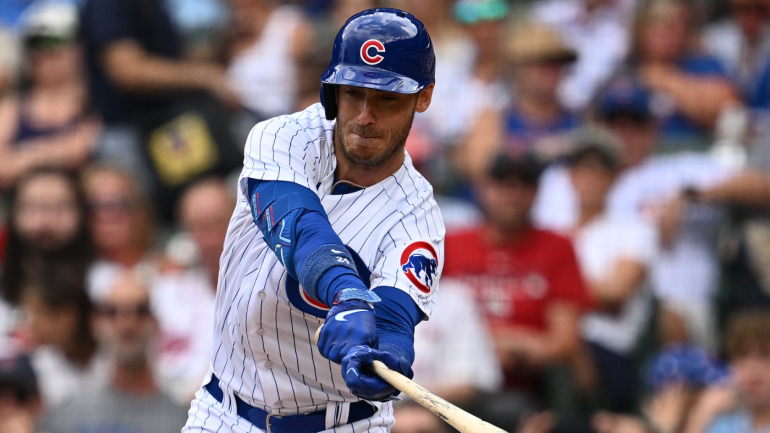
Former MVP Award winner Cody Bellinger's prolonged stay on the free-agent market ended on Sunday morning, as he reportedly agreed to a three-year pact worth $80 million to return to the Chicago Cubs. Bellinger is coming off his finest season in years, having hit .307/.356/.525 (133 OPS+) with 26 home runs and 4.4 Wins Above Replacement, according to the estimates housed at Baseball Reference.
Bellinger's 10th-place finish in MVP voting marked his highest placement since 2019, when he won the National League's edition. He had suffered through some difficult times since, posting just a 66 OPS+ over the course of the 2021-22 seasons. Bellinger's efforts in 2023 still raised some question marks: his ball-tracking data, and particularly his exit velocity, was not as impressive as you would anticipate from someone previously known as a middle-of-the-order slugger. Still, the Cubs must have found Bellinger's price to be worth the risk that he doesn't quite repeat last season.
You might wonder, just what does Bellinger's signing mean for the rest of the top free agents -- and specifically the remaining members of the so-called "Boras Four." That group is now down to three Scott Boras clients who ranked among our top-10 free agents entering the winter: lefties Blake Snell and Jordan Montgomery and third baseman Matt Chapman. Below, CBS Sports has identified four possible ramifications.
1. Door open for shorter deals?
At the risk of reading too much into a single data point, Bellinger's contract raises the possibility that Boras is open to accepting shorter-than-anticipated deals at this stage of the process. Bellinger had been expected to receive five-plus years heading into the offseason, according to several public estimates. Here's a look at those, for reference:
| Publication | Length | Total | AAV |
|---|---|---|---|
6 | $180M | $30M | |
6 | $150M | $25M | |
12 | $264M | $22M | |
Actual | 3 | $80M | $26.7M |
As you can see, Bellinger landed above two of the three AAV predictions, but well beneath the length. (We will note that it stands to reason that those AAV estimates would have been higher the shorter the deal -- length of contract is a form of compensation unto itself.) Might Boras follow a similar playbook elsewhere?
It would make a certain sense on paper, particularly for Snell and Chapman. Both have been high-quality performers, yet each has a risky profile that might cause teams to be reluctant about offering them five-plus-year contracts. (With Snell it's his control; with Chapman it's his hit tool.) A three-year deal might soothe those concerns while still getting the players paid.
We will point out that Bellinger's situation differs from Snell and Chapman in one significant way: he was returning to his former club. Though it's been said that familiarity breeds contempt, in baseball it can often have the opposite effect.
2. Cubs probably out of market
The Cubs had been identified as a potential Chapman suitor, but it's probably fair to put a bow on that speculation. Chicago's payroll is now estimated to sit around $193 million, the second-highest figure in franchise history. The Cubs are still a considerable sum under the luxury tax threshold -- a little more than $30 million -- suggesting they could make further additions, be it now or in-season, without incurring a fee.
Perhaps the best argument against signing Chapman is that the Cubs should save those resources for a position of need. Matt Shaw, the 13th pick in last summer's draft, seems more likely than not to debut this year after scorching his way to Double-A in 2023. He batted .357/.400/.618 with eight home runs in 38 games across three levels.
CBS Sports recently ranked Shaw as the Cubs' third-best prospect, an indication of how promising the top of their farm system is at this point in time.
3. Deadline for regular season readiness nears
One dynamic to keep in mind, at least as it pertains to Snell and Montgomery, is that both will require time to ramp up into regular-season form. Starting pitchers use the exhibition season to slowly stretch their arms, adding 15 or so pitches per appearance until they're ready to regularly flirt with 90-plus offerings during the regular season. That process tends to take three to four complete weeks.
Snell and Montgomery can throw on their own, but there's no equivalent to facing opponents in legitimate competitive situations.
Opening Day for most of the league is slated for March 28, or about a month away. (The Dodgers and Padres will begin the regular season on March 20 with a two-game set in Seoul, South Korea.) That means time is of the essence if Snell and Montgomery are to be part of their team's Opening Day rotations.
Of course, there's no rule stating that Snell and Montgomery (or Chapman for that matter) have to sign before Opening Day.
4. … but that doesn't mean a deal must happen
Boras is considered the best agent in the sport's history for a reason. He's willing to break out every possible trick and tool to get his clients what they deserve. That can mean never counteroffering (as a means of luring teams into bidding against themselves), and it can also mean holding clients out into the regular season if the offers they've received aren't good enough to merit signing.
MLB Trade Rumors recently provided a more comprehensive resource of recent Boras clients to sign late in the winter. Some recent Boras clients to remain on the market well into the season include Dallas Keuchel (June 2019), Stephen Drew (May 2014), and Kendrys Morales (June 2014).
It's too early to know if any or all of the remaining Boras Four will be available on or beyond March 28. But discounting that possibility is doubting Boras' boldness, and more often than not that equals a losing bet.


















